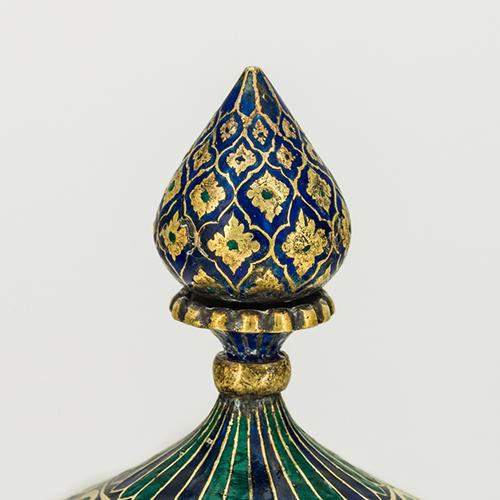

Derived from the Latin word finis, meaning end, a finial is the name given to an ornamental decoration that sits atop a building, monument, or item of furniture. In western culture its classical use in architecture can be traced back to the Ancient Greeks and Romans, although finials were also a common feature in East Asia adorning Buddhist temples and Shinto shrines.
Fine examples from antiquity include this grave marker in the form of a sphinx circa 530 BC, currently in the MET Museum collection, and this magnificent Etruscan ivory finial of rearing lionesses, circa 6th century BC, from the permanent collection at the National Museums Liverpool.
The use of finials became something of a lost art in Britain after the departure of the Romans in the 4th century but returned in the 12th century as the Gothic movement took hold in medieval Europe. Styles varied from simple religious or heraldic motifs to denote a family’s faith or heritage, to elaborate depictions of mythical beasts and grotesque gargoyles.
 The Gothic tradition also brought the finial into the home for the first time with beautifully carved decoration added to furnishings such as balusters, bed posts, cabinets, and chairs. Once again, these varied wildly in form, from simple spherical newel posts and Fleur de Lys to ornately fashioned dragons, griffins, and lions rampant.
The Gothic tradition also brought the finial into the home for the first time with beautifully carved decoration added to furnishings such as balusters, bed posts, cabinets, and chairs. Once again, these varied wildly in form, from simple spherical newel posts and Fleur de Lys to ornately fashioned dragons, griffins, and lions rampant.
The Renaissance movement of 14th century Italy and the subsequent Neo-Classical revival signalled the heyday of the finial as everyday household objects were elevated to the status of high art. Detail and decoration became the priority as wealthy noblemen sought to surpass their peers with ever more elaborate furnishings in silver, bronze, and ormolu.
An exceptional example is this silver gilt soup tureen from the Grand Service made by Paul Storr and purchased by George IV in 1826. The tureen is topped with a remarkably delicate cauliflower finial which sits amid crayfish, turnips, and mushrooms, and is still used for state banquets at Windsor Castle and Buckingham Palace.
 Throughout Europe, well into the late 19th century, finials were used to add a decorative flourish to every conceivable object from clocks, candelabra and chandeliers to tea pots, tankards and even the humble fire grate. Although less common in contemporary furnishings, many modern homes still feature finials at either end of their curtain poles.
Throughout Europe, well into the late 19th century, finials were used to add a decorative flourish to every conceivable object from clocks, candelabra and chandeliers to tea pots, tankards and even the humble fire grate. Although less common in contemporary furnishings, many modern homes still feature finials at either end of their curtain poles.
Click here for examples of the use of finials in antique furniture, ceramics, and silverware.

